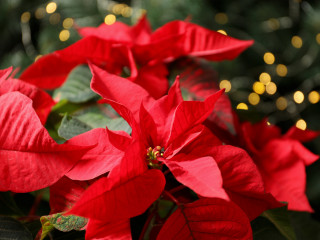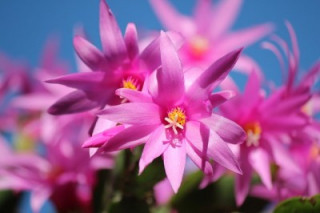We're here to help
Don't make Christmas a mistletoe misery
Poinsettia, mistletoe and holly. They’re all plants we associate with Christmas but did you know they’re poisonous to cats and dogs? They’re not alone either – several popular household plants are toxic. Surveys show almost 10% of cats and dogs have fallen ill after eating foliage. Of those, 43% needed urgent veterinary care, while 15% sadly died.
Here we list the plants you should keep out of your pet’s reach this festive season. If you think your pet may have ingested parts of any of these please contact your vet immediately or, out of hours, find your nearest Vets Now pet emergency clinic or 24/7 hospital here.
1. Poinsettia
Poinsettias are originally from Mexico and are famous for reaching full bloom in December. Their iconic red petals are actually leaves and they’re mildly toxic to dogs and cats. Eating poinsettia can cause drooling, oral pain, and vomiting – but only if they’re ingested in large enough quantities.
On the plus side, the plant contains an irritant sap and it’s unlikely your dog would eat enough to cause serious harm because of the taste and irritation from this.
As with almost all poisons, the size of your dog and the amount they ingest will determine how sick they become. Obviously, the bigger the dog the less likely he is to suffer after eating a small amount.
Our advice is simply to keep poinsettias out of reach.

2. Mistletoe
The plant of love, Mistletoe, is as big a part of Christmas as Santa, but did you know it’s also a vicious parasite that maintains its green colour by sucking nutrients out of trees? On top of that it is highly toxic to cats and dogs and, if eaten, can cause vomiting, diarrhoea, laboured breathing, shock, and even death from cardiovascular collapse.
3. Holly
While holly berries are an important winter food source for birds they’re toxic to dogs, cats and humans. Several varieties include saponins which can cause severe vomiting and diarrhea if eaten. Other symptoms can include drool, lip smacking and head shaking. Don’t bank on the plant’s spikes putting inquisitive pets off either and, for the superstitious, it’s worth bearing in mind that it’s considered unlucky to bring holly into the house before Christmas Eve.
4. Amaryllis
Alongside poinsettias, amaryllis are the best selling Christmas plants and can flower for up to two months if kept warm and dry. Not only are they a popular gift, they’re also a poisonous one. The stalks, flowers and bulbs contain phenanthridine alkaloids which are toxic to both dogs and cats. The highest proportions are in the bulbs. Eating amaryllis can cause vomiting, changes in blood pressure, tremors and seizures.
5. Lily
Certain types of lily – those from the Lilium or Hemerocallis species – are very dangerous for cats. They contain highly toxic substances and ingestion of just two or three leaves, or even water from the vase, can be potentially fatal. While lilies don’t pose quite as severe a risk to dogs, they are still toxic. The calla lily, peace lily, lily of the valley and palm lily, are all deemed dangerous to dogs.

6. Christmas cactus
Another of the yuletide plants, the fibrous leaves of the Christmas cactus can cause irritation to dogs and cats, as well as mild stomach upset, but they’re not deemed toxic.
7. Christmas rose
Originally known as the black hellebore, these hardy plants have been renamed Christmas roses even though they aren’t related to the rose and rarely flower in December. They contain poisonous cardiotoxins and, if eaten, can cause diarrhoea, colic, lethargy, drooling and abdominal pain. It’s worth bearing in mind the entire plant is poisonous, including the roots, stem and flowers.
8. Ivy
If your dog eats ivy, also known by its Latin name hedera helix, it’s likely they will develop vomiting, diarrhoea and drooling. In more severe cases you may also see blood in their vomit or faeces. Skin contact with ivy is also dangerous. It can cause conjunctivitis, itchiness and rashes. It’s worth noting that so-called poison ivy, rhus radicans, is a different plant. It can also trigger a painful reaction in dogs although it only grows in North America.
9. Daffodil
Although daffodils are synonymous with spring, they do start appearing as early as December if the winter has been mild. The yellow flowers contain a poisonous alkaloid that triggers vomiting while crystals in the bulbs are severely toxic and can cause serious conditions such as cardiac arrhythmias or respiratory depression.
